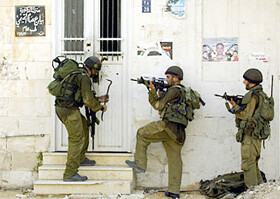Palestinian Center for Human Rights 28 August 2003

This week, Israeli occupying forces escalated their illegal military actions in the Occupied Palestinian Territories (OPT), causing more casualties among Palestinian civilians. PCHR is concerned that further escalation may take place, as Israeli officials stated that Israeli occupying forces would continue to target Palestinian activists. In flagrant disregard for the lives of Palestinian civilians, Israeli occupying forces committed more extra-judicial assassinations. They invaded the northern West Bank towns of Nablus and Jenin. They also conducted a series of incursions into Palestinian Authority controlled areas, during which they raided and destroyed houses and arrested dozens of Palestinians. Israeli occupying forces continued to shell Palestinian residential areas and have maintained the total siege imposed on the OPT. This week, 21-27 August 2003, 11 Palestinians were killed and approximately 50 others were wounded by Israeli occupying forces. 10 of the victims were killed in extra-judicial assassinations perpetrated by Israeli occupying forces.
In a continuation of the policy of extra-judicial assassinations officially adopted by the Israeli political and security establishments against Palestinian field activists and political leaders, Israeli occupying forces carried out 4 assassination attempts in Gaza city and Nablus. One of these assassination attempts failed and a passing Palestinian civilian was killed. The other assassination attempts left 9 Palestinians dead. 6 targeted persons were extra-judicially assassinated in these attacks: a prominent leader of Hamas movement, Isma’il Abu Shanab and two of his bodyguards, 4 members of Ezziddin al-Qassam Brigade, the military wing of the Hamas movement and 1 member of al-Aqsa Martyrs Brigade, the military wing of Fatah movement. In addition, approximately 50 Palestinians were injured, two of whom were arrested while they were receiving medical treatment in an intensive care unit at a hospital in Nablus.
During two of these assassinations, Israeli warplanes were seen flying over the area, a method used by Israeli occupying forces to hide the sounds of attacking helicopters.
In violation of international humanitarian law, especially the Geneva Convention Relative to the Protection of Civilian Persons in Time of War of 1949, article 33 of which prohibits punishing any protected person for “an offence he or she has not personally committed,” Israeli forces took retaliatory measures against the families of Palestinians Israel alleges have ordered, facilitated, or carried out attacks against Israeli targets. In this context, they destroyed 7 Palestinian houses in Hebron, Jenin, Nablus and Tulkarm and Tulkarm. Three of the houses destroyed were located in Nablus.
Israeli occupying forces continued to shell Palestinian residential areas, especially in Rafah and Khan Yunis. Four Palestinian civilians, including a child, were wounded and a number of houses were damaged. On 23 August 2003, Israeli occupying forces moved into Rafah and razed 8 donums of Palestinian agricultural land. In the West Bank, Israeli occupying forces conducted a series of incursions into Palestinian controlled areas, accompanied by indiscriminate shelling and shooting. About 20 Palestinian civilians were wounded. Israeli occupying forces also raided some houses and arrested a number of Palestinians.
In an apparent willful killing, on Wednesday, 27 August 2003, Israeli soldiers shot dead a Palestinian civilian near Bilal Ben Rabah mosque in front of Rachel Tomb, north of Bethlehem. They claimed that he was holding a knife, but field investigators refuted this claim.
Israeli occupying forces have continued work on the separation wall. They have confiscated more areas of Palestinian land and isolated more Palestinian residential areas for this purpose. In this context, they demolished dozens of Palestinian houses and stores in Nazlat ‘Eissa village, north of Tulkarm, and razed areas of Palestinian agricultural land in Abu Dis village, east of Jerusalem, for the purpose of establishing the wall.
Israeli occupying forces have maintained a strict siege on the Occupied Palestinian Territories, especially in the West Bank. While Israeli forces redeployed on the main roads in the Gaza Strip, they have restricted movement at border crossings and have closed the Beit Hanoun (Erez) crossing. They have maintained the siege imposed on the al-Mawasi area in the southern Gaza Strip and the al-Sayafa area in the north. They have also maintained the closure of the Rafah-Khan Yunis western road, a part of Salah al-Din Street near “Kfar Darom” settlement in the central Gaza Strip, and closed Abu al-‘Ajin road between Wadi al-Salqa village in Deir al-Balah and al-Qarara village in Khan Yunis. On Friday, 22 August 2003, Israeli occupying forces closed the junctions of al-Matahen, Abu Houli and al-Shuhada on Salah al-Din Street, the main road between the north and south of the Gaza Strip, partitioning the Gaza Strip into 3 isolated zones. They prevented movement of Palestinian civilians until 20:00. Israeli occupying forces have also blocked al-Shuhada junction, south of Gaza city.
In the West Bank, Israeli occupying forces have maintained a strict siege on Palestinian communities, isolating them from one another. They have restricted movement of Palestinians at military checkpoints, despite Israeli claims that a number of military checkpoints were dismantled. They re-closed a number of roads and erected dozens of roadblocks. They also moved into a number of towns, and have imposed curfews on a number of villages.
To download the full report click here.